|
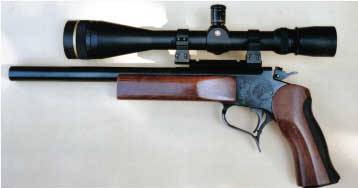
|
|
"This 6.5x20 with its
index matched coating system is a very exceptional performer." |
|
Iíve written about other 6.5 X 20 scopes in the past and have stated
that one of the main things that Iíve really liked about them is the fact that
theyíre really versatile. Their power range is just like Goldilocks porridge -
in other words itís is just right for just about anything you could want to do.
Itís true you can get scopes with a lot more magnification but then you also get
less brightness, less eye relief, a more narrow field of view, and eye placement
in relation to the lens becomes more critical. Additionally, more magnification
= more expense. A lot of these problems are avoided with a scope like this one
which falls in at the top end of what I would call the medium magnification
range.
(Just to avoid any confusion, I arbitrarily define "high power" as
being 24X and up, medium power as being from 12 to 20X, and low power being from
1 to 10X.)
|
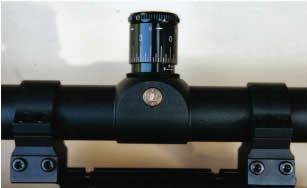
|
|
"The clicks on the knobs were
distinct but not hard and the Leupold rings are both handsome and
functional." |
|
However in the hectic market place of sports optics, there are a fair
number of other manufacturers that also make a pretty good 6.5 X 20. So what
makes this particular scope from Leupold better than the competition? Basically
two things. The first is that itís an EFR model. So whatís that? EFR stands for
"Extended Focus Range". That means that this scope is made to focus all the way
down to 10 meters - even when set on its highest magnification. In fact, when
using the scope, I found that it would focus down to around 8 meters or there
abouts. Not surprisingly, the scope is primarily marketed as an air gun
competition model, which of course makes it a perfect candidate for air gun
silhouette. However, unlike many airgun scopes, that are suitable for only air
gun use exclusively, because of their often flimsy construction or the limited
range of their focusing ability, the Leupold is built and tested to the same
tough standards as all Leupold scopes. The result is that it can be used even on
the most powerful hunting rifles available, and at any distance from ten meters
to infinity. This makes the Leupold even more versatile than the competition
because it allows me to put it on either my Daisy 747, my TC 22 Hornet, my
XP-100 standing unlimited gun, my Kimber 222 varmint rifle, or my Remington
30-06 whenever I want. Now thatís versatile.
|
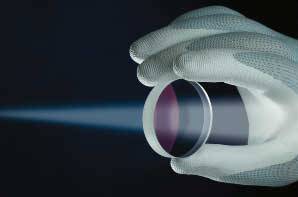
|
|
"Leupold's
lens system on the new VX-III line approaches the theoretical limits of
light transmission." |
|
The second thing that makes this scope different than the competition
is that itís one of the new VX-III line which uses Leupoldís "Index Matched"
light management system. This is arguably the most sophisticated sports optics
design in the industry. Here, the coatings on each of the eight lenses in the
scope are custom matched to the type of glass used. I know itís commonly assumed
that all the lenses in a scope are all made from the same type glass. Not so.
Some types of glass are better suited for some lens applications than for
others. Consequently, to put identical coatings on all these disparate lens
elements isnít as optically effective as tailor matching them. The end result is
maximum light transmission and a noticeably brighter image. Indeed, if you
doubled or even tripled the amount of money you spent for a 6.5 X 20 scope, I
serious doubt you could find a brighter image out of this sized objective lens
anywhere. It is simply the brightest 40mm objective system out there - period.
In appearance, this
scope is handsome in a conventional sense and people often asked about it when
they saw it at the range. Itís 14" long and weighs in at 19 ounces. Itís
available in glossy black, matte black, and in silver. I chose the matte black.
|
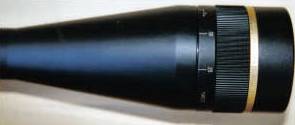
|
|
"Adjusting the objective lens was smooth
and easy." |
|
Along the same vein,
adjusting the front objective lens on many scopes is often
difficult. This isnít too surprising. Whenever a gun is fired,
torque or a twisting motion is generated by the bullet being spun
down the barrel. The heavier the bullet and the faster its velocity,
the more torque is produced. On some scopes, this torque will
actually turn the objective lens adjustment ring. Consequently,
after a couple of shots, your parallax adjustment will be off.
|
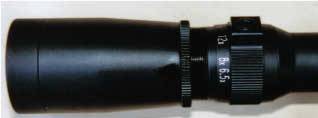 |
|
"A standard lock rings prevents the eyepiece from moving under
recoil." |
|
To compensate, manufacturers will sometimes make this adjustment rather
stiff, which in turn, makes it difficult to make fine adjustments. On the
other hand, the Leupold AO ring moved smoothly with no stiffness or
binding. It didnít move under heavy recoil either, even when I mounted it
on my 30-06 and stoked it up with some heavy 180 grain loads.
The target knobs are the high type with easy to read numbers and index
markings. Theyíre also easy to zero adjust through the standard Leupold
method of backing off three set screws, lifting the turret off, and then
replacing it with "0" aligned with the index mark. Additionally, I found
the clicks to be firm and positive with plenty of audible and tactile
feedback, but not too much. Some scopes over do this feature and the
clicks become hard and sticky, or at the other extreme, soft and mushy.
Again, the clicks here felt just right - not too hard and not too soft.
Each click equals a quarter inch in adjustment movement and there is a
total of 38 inches in adjustment range for both windage and elevation.
The field of view at 100 yards is 14 feet at 6.5 power and 5.5
feet at 20 power. Consequently, if you were using the scope at 10 yards the
field of view would be 1.4 feet and .55 feet respectively, which is plenty for
air gun silhouette. In addition, eye relief is a whopping 5 inches at low power
and still generous 3.5 inches at the very top end. Consequently, anyone using
this scope for any of the standing disciplines shouldnít have any problems at
all with getting the full field of view while keeping the scope a safe distance
from their eye.
The user also has a choice of either a Leupold target dot, which seems
to float in space without the crosshairs being visible, or a fine crosshairs
type reticule. I would guess that most silhouette shooters would prefer the dot.
If you want a different type of reticule, the Leupold custom shop has several
others that you can choose from.
When I evaluate a scope in the field, thereís a couple of key
characteristics that I really concentrate on i.e. color fidelity, brightness,
and resolution across the entire field of view.
Color fidelity refers to the scopeís ability to show the colors of the
object being viewed as they really are. Some manufacturers will shave costs by
using glass in their lenses that contain impurities, such as iron. When iron is
added to silica, it lowers its melting point and saves fuel. The lenses from
this glass can be expertly ground to produce good images. The problem however is
that the images will have an undesirable green tint from the iron. Other
impurities can impart a yellow tint. Whatever color the tint, it will detract
from your ability to see what you want to see.
The best way to detect impurities in a lens is to view a white object
such as a piece of high quality printer paper. If thereís any tinting present,
it will easily be seen. The VX-III Leupold passed this evaluation with flying
colors. White was white. It wasnít ivory, pale yellow, cream, or anything else.
It was simple, pure, bright, clear white, just as it should be.
Brightness is what the whole VX-III line is all about. I can assure
you that the images in this this scope are bright. In fact, they are
exceptionally bright. The Leupold objective is a 40mm. I scrounged around my gun
room and discovered that I own five 40mm variable scopes from various
manufacturers. When set on the same magnification setting, the Leupold is
significantly brighter. In fact itís brighter at 20X than some of these scopes
are at far lower settings. The Leupold index matching system works exceedingly
well.
Light transmission efficiency is one thing, but resolution, or the
ability to produce a sharp image across the whole lens is quite another.
Inexpensive scopes will often have passable resolution in the very center of the
image. But as you turn your eye away from that small area in any direction,
resolution starts fall off rapidly.
I checked out the Leupoldís resolution by using the home made chart
that Iíve discussed in these pages many times. Itís simply several lines of
"Oís" which decrease in size as you move to the top of the page. The idea is to
determine which line of Oís that can be clearly distinguished without blurring.
Increasing magnification decreases resolution and darkens the image, so lessor
quality scopes donít do well when put through their paces with this chart. The
Leupold was able to clearly resolve 12 point type when set on its highest power.
This is exceptional performance for a 40mm system. Indeed, the image was
exceedingly clear and sharp with fine edges. When I viewed the resolution chart
at the extreme edges of the field of view, there was no perceivable fall off in
resolution. This is as good as it gets.
In summary, if youíre looking for a scope that you can use for almost
every shooting activity that exists, and which handily outperforms the
competition , this is the one you want. This is literally one of those scopes
youíll keep forever.
|
![]()